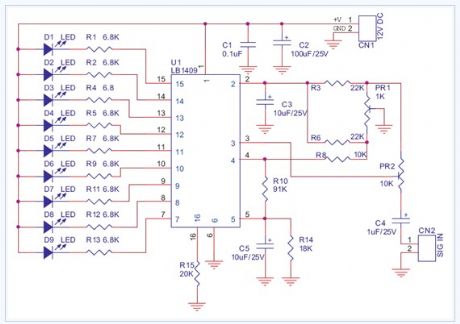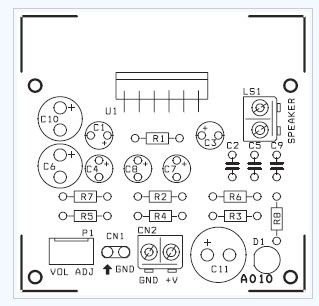
Circuit Diagram
Index 129
Audio Perimeter Monitor electronic circuit
Published:2013/4/1 3:05:00 Author:Ecco | Keyword: Audio Perimeter Monitor
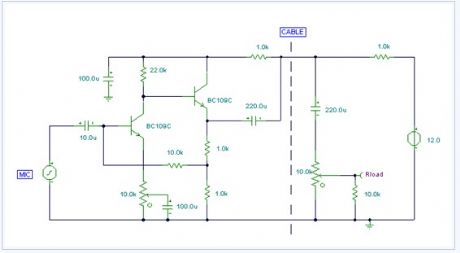
Using a single cable such as speaker wire or doorbell cable, this circuit can be remotely positioned, for example, at the bottom of a garden or garage, and used to detect all sound in that area. The cable can be buried in a hosepipe or duct and is concealed out of sight. The mic is an ordinary dynamic mic insert and should be housed in a waterproof enclosure with the rest of the circuit. The mic output is amplified by the two transistors, the output is fed down the cable via the 220u capacitor. Here, it has a dual purpose of preventing the DC supply from upsetting the bias of the circuit, and also allowing the smaller ac audio output to pass down the line. At the power supply, the audio is recovered by the 10k preset and 220u capacitor. It is used to feed a small audio amplifier (such as the 2watt design) shown earlier on this site.
(View)
View full Circuit Diagram | Comments | Reading(904)
Audio Vu Meter 9 Leds electronic circuit diagram
Published:2013/4/1 3:04:00 Author:Ecco | Keyword: Audio, Vu Meter 9 Leds
View full Circuit Diagram | Comments | Reading(989)
Automatic Loudness Control electronic circuit
Published:2013/4/1 3:03:00 Author:Ecco | Keyword: Automatic Loudness Control
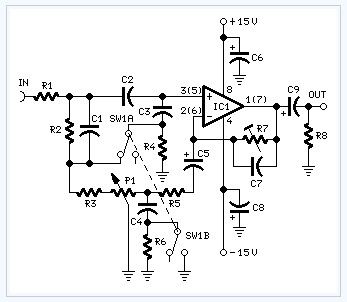
In order to obtain a good audio reproduction at different listening levels, a different tone-controls setting should be necessary to suit the well known behaviour of the human ear. In fact, the human ear sensitivity varies in a non-linear manner through the entire audible frequency band, as shown by Fletcher-Munson curves.A simple approach to this problem can be done inserting a circuit in the preamplifier stage, capable of varying automatically the frequency response of the entire audio chain in respect to the position of the control knob, in order to keep ideal listening conditions under different listening levels.Fortunately, the human ear is not too critical, so a rather simple circuit can provide a satisfactory performance through a 40dB range.The circuit is shown with SW1 in the Control-flat position, i.e. without the Automatic Loudness Control. In this position the circuit acts as a linear preamplifier stage, with the voltage gain set by means of Trimmer R7.Switching SW1 in the other position the circuit becomes an Automatic Loudness Control and its frequency response varies in respect to the position of the control knob by the amount shown in the table below.C1 boosts the low frequencies and C4 boosts the higher ones. Maximum boost at low frequencies is limited by R2; R5 do the same at high frequencies.
(View)
View full Circuit Diagram | Comments | Reading(1581)
Bass-treble Tone Control Circuit electronic circuit diagram
Published:2013/4/1 3:02:00 Author:Ecco | Keyword: Bass-treble Tone Control
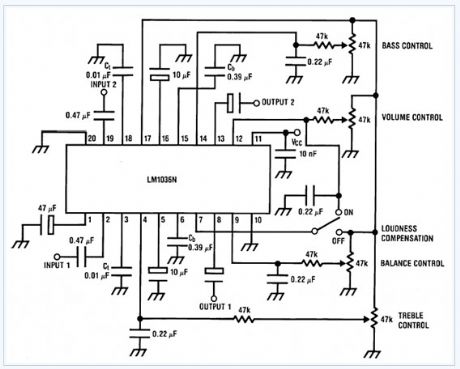
The LM1036 is a DC controlled tone (bass/treble), volume and balance circuit for stereo applications in car radio, TV and audio systems. An additional control input allows loudness compensation to be simply effected. Four control inputs provide control of the bass, treble, balance and volume functions through application of DC voltages from a remote control system or, alternatively, from four potentiometers which may be biased from a zener regulated supply provided on the circuit. Each tone response is defined by a single capacitor chosen to give the desired characteristic.
(View)
View full Circuit Diagram | Comments | Reading(2894)
Amplifier Timer electronic circuit
Published:2013/4/1 3:00:00 Author:Ecco | Keyword: Amplifier Timer
View full Circuit Diagram | Comments | Reading(1026)
Amplifier Of Acoustic Frequencies And Preamplifier electronic circuit
Published:2013/4/1 2:59:00 Author:Ecco | Keyword: Amplifier, Acoustic Frequencies, Preamplifier
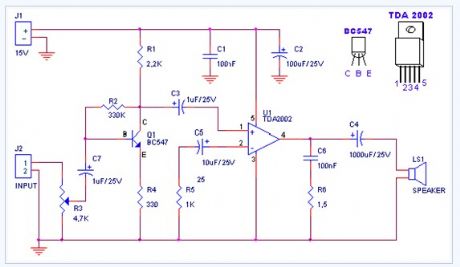
Tendency of catering: 15VForce of expense: 4,2Wrms in the 4WMinimal signal of entry: 94mVp-p with preamplifier, 0,65Vp-p without the preamplifier.
(View)
View full Circuit Diagram | Comments | Reading(1054)
Amplified Ear electronic circuit
Published:2013/4/1 2:57:00 Author:Ecco | Keyword: Amplified Ear

The heart of the circuit is a constant-volume control amplifier. All the signals picked-up by the microphone are amplified at a constant level of about 1 Volt peak to peak. In this manner very low amplitude audio signals are highly amplified and high amplitude ones are limited. This operation is accomplished by Q3, modifying the bias of Q1 (hence its AC gain) by means of R2. A noteworthy feature of this circuit is 1.5V battery operation. Typical current drawing: 7.5mA.
(View)
View full Circuit Diagram | Comments | Reading(1427)
60w Linear Amplifier electronic circuit diagram
Published:2013/4/1 2:56:00 Author:Ecco | Keyword: 60w Linear Amplifier
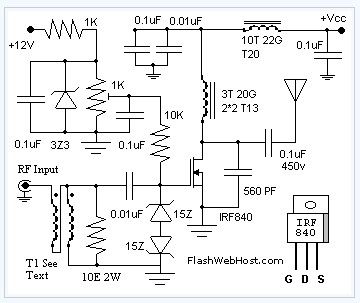
The 60 Watt linear amplifier is simple all solid state circuit using power mosfet IRF840. The IRF series of power transistors are available in various voltage and power ratings. A single IRF840 can handle maximum power output of 125 watts. Since these transistors are used in inverters and smps they are easily available for around Rs: 20/-.The IRF linear amplifier can be connected to the out put of popular VWN-QRP to get an output of 60 Watts. The circuit draws 700 ma at 60 Volt Vcc. Good heat sink is a must for the power transistor.Alignment of the circuit is very easy. Connect a dummy load to the out put of the circuit. You can use some small bulb like 24V 6Watts as the dummy load. I have even used 230V 60Watts bulb as dummy load with my IRF840 power amplifier working at 120Volts. Adjust the 10K preset to get around 100 ma Drain current. I used gate voltage of 0.8V with my linear amplifier. A heigh gate voltage can make the power transistor get distroyed by self oscillation. So gate voltage must be below 2V and fixing at 1V will be safe.Bifalar transformaer T1 is wound with 8 turns 26SWG on 1.4 x 1 balun core.The coil on the drain of IRF is 3 turns 20 SWG wound on 4 number of T13.9 torroids (two torroids are stacked to form a balun core). The RFC at the Vcc line is 20 Turns 20 SWG wound on T20 torroid.
(View)
View full Circuit Diagram | Comments | Reading(2842)
60w Guitar Amplifier electronic circuit diagram
Published:2013/4/1 2:54:00 Author:Ecco | Keyword: 60w Guitar Amplifier
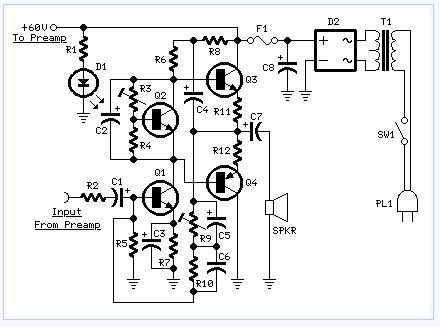
Bass, Treble, Harmonic modifier and Brightness controls. Output power: 40W on 8 Ohm and 60W on 4 Ohm loads
(View)
View full Circuit Diagram | Comments | Reading(1575)
50 Watt Amplifier electronic circuit diagram
Published:2013/4/1 2:50:00 Author:Ecco | Keyword: 50 Watt Amplifier
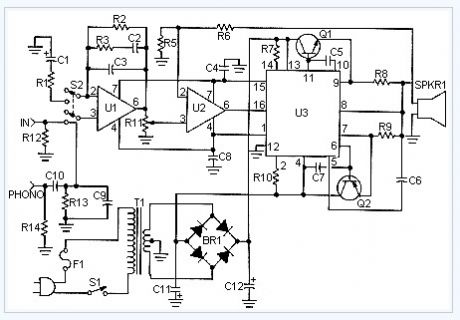
This is a handy, easy to build general purpose 50 watt amp. The amp has an input for a radio, TV, stereo or other line level device. It also has a phono input for a record player, guitar, microphone or other un-amplified source. With the addition of a low pass filter at the input, it makes a great amp for a small subwoofer.
(View)
View full Circuit Diagram | Comments | Reading(1093)
5-band Graphic Equalizer electronic circuit diagram
Published:2013/4/1 2:49:00 Author:Ecco | Keyword: 5-band Graphic Equalizer
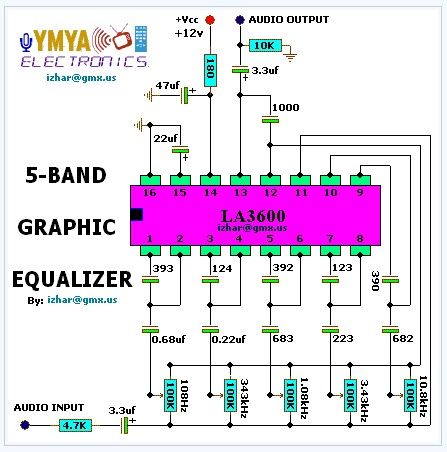
This complete high quality, low noise 5-BAND GRAPHIC EQUALIZER circuit is based around Monolithic Linear integrated circuit LA3600 manufactured by SANYO. This circuit is very easy to build and has good Quality. You can use it with Portable component stereos, tape-recorders, radio-cassette recorders, car stereos etc... It is On-chip one operational amplifier. 5-band graphic equalizer for one channel can be formed easily by externally connecting capacitors and variable resistors which fix fo (resonance frequency). Series connection of two LA3600�s makes multiband (6 to 10 bands) available. It is Highly stable to capacitive load. Maximum supply voltage VCC max 20V must not be exceeded. The operating voltage is in the range of 5 to 15V. Application of power with the pin-to-pin spaces shorted causes breakdown or deterioration of the IC to occur. When mounting the IC on the board or applying power, make sure that the pin-to-pin spaces are not shorted with solder, etc.
(View)
View full Circuit Diagram | Comments | Reading(2204)
3 Transistor Audio Amp electronic circuit diagram
Published:2013/4/1 2:48:00 Author:Ecco | Keyword: 3 Transistor Audio Amp
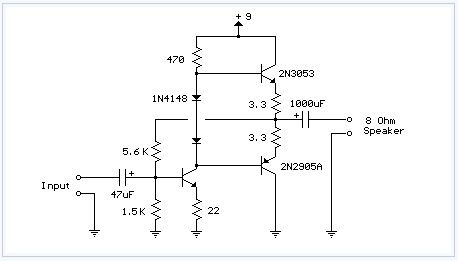
Here is a little audio amplifier similar to what you might find in a small transistor radio. The input stage is biased so that the supply voltage is divided equally across the two complimentary output transistors which are slightly biased in conduction by the diodes between the bases. A 3.3 ohm resistor is used in series with the emitters of the output transistors to stabilize the bias current so it doesn't change much with temperature or with different transistors and diodes. As the bias current increases, the voltage between the emitter and base decreases, thus reducing the conduction. Input impedance is about 500 ohms and voltage gain is about 5 with an 8 ohm speaker attached. The voltage swing on the speaker is about 2 volts without distorting and power output is in the 50 milliwatt range. A higher supply voltage and the addition of heat sinks to the output transistors would provide more power. Circuit draws about 30 milliamps from a 9 volt supply.
(View)
View full Circuit Diagram | Comments | Reading(2084)
3 Line Mixer electronic circuit
Published:2013/4/1 2:47:00 Author:Ecco | Keyword: 3 Line Mixer
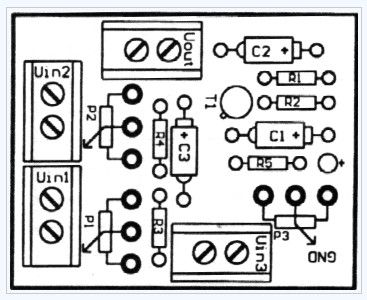
This project is a 3 or more lines mixer. For more than 3 inputs you can repeat the input parts (P=10K R=22K). It powered with 9Vdc.
(View)
View full Circuit Diagram | Comments | Reading(519)
3 Channel Spectrum Analyzer electronic circuit diagram
Published:2013/4/1 2:47:00 Author:Ecco | Keyword: 3 Channel Spectrum Analyzer

This 3 channel 15 LED spectrum analyzer is the perfect addition to any audio amp project. It produces fantastic displays on three LED bars that can be individually adjusted for any particular frequency range. The circuit will take line level output from most any audio source, and operates on 12V DC. This means that it can even be run in a car.
(View)
View full Circuit Diagram | Comments | Reading(3643)
2n3055 Power Amplifier 60w electronic circuit diagram
Published:2013/4/1 2:45:00 Author:Ecco | Keyword: Power Amplifier
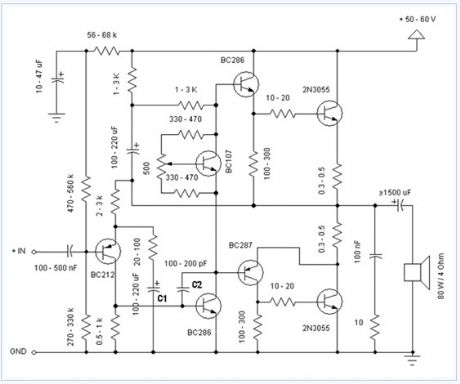
Simple and low cost. The optimal supply voltage is around 50V, but this amp work from 30 to 60V. The maximal input voltage is around 0.8 - 1V. As you can see, in this design the components have a big tolerance, so you can build it almost of the components, which you find at home. The and transistors can be any NPN type power transistor, but do not use Darlington types... The output power is around 60W.
(View)
View full Circuit Diagram | Comments | Reading(2720)
25w Mosfet Audio Amplifier electronic circuit
Published:2013/4/1 2:44:00 Author:Ecco | Keyword: 25w, Mosfet Audio Amplifier
View full Circuit Diagram | Comments | Reading(1822)
22 Watt Audio Amplifier electronic circuit diagram
Published:2013/4/1 2:43:00 Author:Ecco | Keyword: 22 Watt Audio Amplifier

The 22 watt amp is easy to build, and very inexpensive. The circuit can be used as a booster in a car audio system, an amp for satellite speakers in a surround sound or home theater system, or as an amp for computer speakers. The circuit is quite compact and uses only about 60 watts.
(View)
View full Circuit Diagram | Comments | Reading(1665)
20w Bridge Audio Amplifier electronic circuit
Published:2013/4/1 2:42:00 Author:Ecco | Keyword: 20w, Bridge Audio Amplifier
View full Circuit Diagram | Comments | Reading(1217)
20w Audio Amplifier Using Lm1875 electronic circuit
Published:2013/4/1 2:41:00 Author:Ecco | Keyword: 20w Audio Amplifier
View full Circuit Diagram | Comments | Reading(1512)
200w Audio Amplifier electronic circuit
Published:2013/4/1 2:39:00 Author:Ecco | Keyword: 200w Audio Amplifier
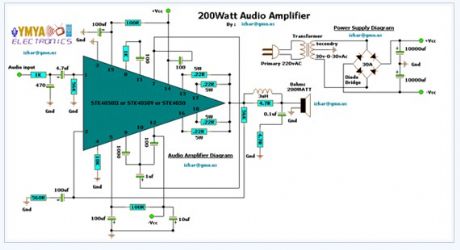
Output Power : 200WattsLoad Resistance : 8ohmsInput impedance : 55KMaximum supply voltage : (+95v)-0-(-95v)Recommended supply voltage : (+66v)-0-(-66v)This complete high quality, low noise mono audio power amplifier is based around the Hybrid Integrated Circuit STK4050 manufactured by Sanyo. The circuit incorporates volume and has a maximum music output power of 200W.The circuit incorporates an on board power supply; therefore, only centre tapped transformer is required to power the circuit. I t has very good quality sound. U can use it with your Home Theatre your PC & etc... You can also use it as Subwoofer Amplifier. It is a compact package for THIN-TYPE Audio sets. Easy Heatsink design to disperse heat generated in THIN-TYPE audio sets. Constant-Current circuit to Reduce supply switch-ON and switch-OFF shock noise. External supply switch-On and switch-OFF shock noise muting, Load short-circuit protection, thermal shutdown and other circuits can be tailored-designed.
(View)
View full Circuit Diagram | Comments | Reading(1683)
| Pages:129/2234 At 20121122123124125126127128129130131132133134135136137138139140Under 20 |
Circuit Categories
power supply circuit
Amplifier Circuit
Basic Circuit
LED and Light Circuit
Sensor Circuit
Signal Processing
Electrical Equipment Circuit
Control Circuit
Remote Control Circuit
A/D-D/A Converter Circuit
Audio Circuit
Measuring and Test Circuit
Communication Circuit
Computer-Related Circuit
555 Circuit
Automotive Circuit
Repairing Circuit
